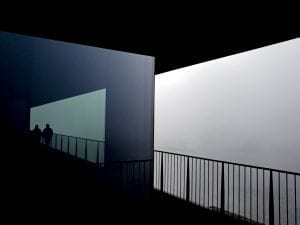“In some landscapes Brutalism might seem out of place, but in a country of rugged contours, magnificent castles and ancient megaliths the rough grey mass and monolithic beauty of post-war concrete often feels entirely appropriate,” begins writer John Grindrod in the introduction of Brutal Wales. The book is visual artist Simon Phipps’ (b. 1964) monochrome photographic exploration of the country’s often-forgotten architectural heritage. Here, Cardiff’s Central Police Station building, pierced through with rows of windows, goes hand in hand with the arches of the desolate Semtex Boiler House in Brynmawr.


Brutalist architecture emerged in the late 1940s. Its significant features include imposing concrete forms, expressive structures, rough surfaces and unusual shapes. The term “brutalism” was first used by British architect Alison Smithson to describe an unexecuted project with partner Peter Smithson. Some of the best-known Brutalist structures include Denys Lasdun’s National Theatre in London (1976), Le Corbusier’s Unite D’Habitation in Marseille (1952) and Gerd and Magdalena Hänska’s Mäusebunker (1982) in Berlin. Now, alongside Germany, France and England, Phipps’ series places Wales on the map of modernist destinations.
For several years, Phipps has been chronicling overlooked sites. After his previous titles Brutal London (2016), Finding Brutalism (2017), Concrete Poetry (2018) and Brutal North (2020), Brutal Wales is the newest addition to Phipps’ black and white documentary series. The publication collates images of over 60 notable, as well as many lesser-known, structures. As Grindrod says: “In their bold imagination and visionary execution [these buildings] help connect us to a period in our history that is all too easily overlooked and neglected – the recent past.” The album provides an architectural and historical perspective on the nature of Welsh Modernism and its effect on the nation’s towns and landscapes.

From an unnamed electricity substation in Swansea to the sculptural forms of Margam Crematorium, these monochrome shots record the style’s defining characteristics. The walls of Argoed High School in Mynydd Isa retain the mark of the wooden shuttering, whilst Mold’s County Hall has a truly dynamic façade. This book shows that, contrary to popular opinion, Brutalist structures can be rich in texture and detail. Here, we also gain an insight into the Trostre steelworks in Llanelli and the undercroft of George Street Bridge in Newport.
“Phipps project” – states academic Mark Durden in the closing section – “is giving visibility to the extraordinary variety and richness of Britain’s post-war modernist architecture … in showing us the importance of the craft and artistry integral to even its most lowly functional buildings and structure, he offers us a valuable, comprehensive and beautiful manual and guide for this architecture’s preservation.” In an age when the Twentieth Century Society (C20) continues to campaign to save sites such as the Ringway Centre in Birmingham, Phipps’ volume serves as a reminder of the architectural heritage we must protect.
Simon Phipps: Brutal Wales | September Publishing
Words: Fruzsina Vida
Image credits:
1. Simon Phipps, Margam Crematorium, Port Talbot
2. Simon Phipps, The Crown Buildings(Cathays Park Buildings), Cardiff
3. Simon Phipps, Margam Steel Works (Abbey Works) (now Tata Steel), Port Talbot
4. Simon Phipps, County Hall, Mold





